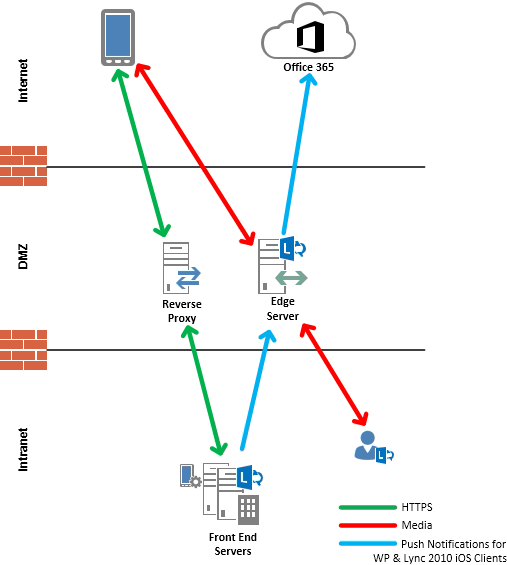Lync 2013 Mobility
Update 4/2/13 - Updated for release of Android client.
Update 3/12/13 - Updated for release of iOS client.
With the release of the Lync Server 2013: February 2013 Cumulative Updates, additional features are available with Lync mobility. In order to take advantage of these new features, you will need to install the Lync 2013 version of the mobile client for the respective mobile platform. The Lync 2013 mobile client will be released for Windows Phone, iOS, and Andriod through their respective marketplace. The time and availability of the mobile apps will vary between each marketplace.
What's New?
There are a bunch of new features in both the Lync 2013 mobile client and the server. The list below has some of the important changes:
- Mobile clients are built using the Unified Communications Web API (UCWA). This is the same API used to build the Lync 2013 Web App. You can find out some more information about UCWA from the Unified Communications Web API website.
- Support for Audio/Video over 3G/4G/Wi-Fi.
- Support for Application Sharing via the Lync 2013 iPad client.
- Layer 7 HLB no longer required. The requirement for cookie-based persistence has been removed and only Layer 4 HLB is now required.
- Federation with O365 environment for push notifications on iOS clients is no longer required. When using the Lync 2013 mobile client a VoIP socket is used instead of push notifications. The Lync 2010 mobile client for iOS still uses push notifications, so if you still need to support legacy clients in your environment you will still need to enable federation with O365.
- Longer lived registration. You won't be signed out of the mobile client if you haven't launched the application in more than 3 days.
- HD photo support from Exchange 2013.
Deployment Considerations
Since A/V is now supported over 3G/4G, or Wi-Fi the Edge Server plays a larger role in mobility deployments. In the diagram below, you can see that the mobile client will still send signaling information via the Reverse Proxy, but it will now send media via the A/V Edge interface on the Edge Server:
When in co-existence with Lync Server 2010, your Lync autodiscover URLs can still resolve to a Lync Server 2010 Front End Server or Director. The Lync autodiscover service will be return the correct external web services FQDN for your user based on your homed pool. The media traffic from the Lync 2013 mobile client can also use a Lync Server 2010 Edge Server.
Windows Phone Client Interoperability
| MobileClient | Install on WP 7.5 | Install on WP 8 | Connect toLync Server 2010 | Connect toLync Server 2013 |
| Lync 2010 | ✔ | ✔ | ✔ | ✔ |
| Lync 2013 | ✖ | ✔ | ✖ | ✔ |
From the table above, you can see that the Lync 2013 Windows Phone mobile client can only be installed on Windows Phone 8 and can only connect if the user is homed on a Lync Server 2013 pool that has the cumulative update installed. If you try to sign in to a Lync Server 2010 Front End Server or a Lync Server 2013 Front End Server without the cumulative update using the Lync 2013 mobile client you will see the following error message:
Error: "You can't sign in with this version of Lync. Please install Lync 2010."
iOS and Android Client Interoperability
The Lync 2013 iOS client has been released for iPhone and iPad. It is now available in the iTunes store. You will need to be running iOS 6.0 or later. Keep in mind that for this client to work you will need to be homed on a Lync Server 2013 Standard Edition Server or Enterprise Edition Pool with at least the Lync Server 2013: February 2013 Cumulative Updates installed. Also the Lync 2013 Android client has been released. It is now available in the Google Play store. The list of supported Android phones is listed in KB2829747.
